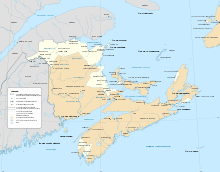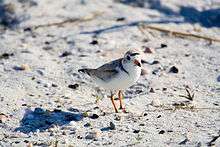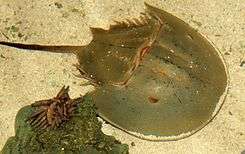Atlantic Northeast
The Atlantic Northeast is a region of North America, which includes the US states of Connecticut, Massachusetts, Rhode Island, New Hampshire, Vermont, and Maine, as well as the Canadian Maritimes.
The Atlantic Northeast region is noted for its cultural unity, stark climate, landscape of dense forests, and a shared economic history in the exploitation of logging and the regional fishery. Further uniting this area is the "Gray Zone" which is an area of land and sea which is claimed by both Canada and the United States. It is located off the coasts of New Brunswick and Maine. The only land within this area are two islands, Machias Seal Island and North Rock. The "Gray Zone" is one of four areas between the two countries whose sovereignty is still in dispute, but is the only one of the disputed areas containing land. In 1979, both countries filed a joint application to the International Court of Justice to avoid having the dispute settled when oceanic boundaries in the area were set for mineral and fishing rights. Canadians have had a continuous presence in the area since 1832 when a lighthouse was built.[1]
Since the Atlantic Northeast is such a large region, it is home to many different types of wildlife, sports teams, and geographical locations. The Atlantic Northeast is home to the Boston Celtics, Boston Bruins, New England Patriots, Halifax Hurricanes, Boston Red Sox and many more. It also includes many notable species including the Bald Eagle, Atlantic Salmon, and the Swamp Pink. Lastly, the Atlantic Northeast includes many geographical places of interest including the Northeast Canyons and Seamounts Marine National Monument and Salem, Massachusetts, home of the Salem Witch Trials.
Though cross-border connections are widely acknowledged, the area has rarely been given a single name. "Atlantic Northeast" is a term that has been used most prominently in discussions of regional folk culture, another name that is used is Atlantica."
These names are often tied to various proposals for greater economic or political integration of the region
Demographics
| State | White | Black | Alaska Native | Asian | Pacific Islander | Total Population |
| Maine | 1,288,646 | 22,100 | 18,718 | 18,445 | 1,008 | 1,329,328 |
| Connecticut | 3,012,178 | 433,855 | 37,794 | 160,290 | 6,864 | 3,590,886 |
| Massachusetts | 5,634,710 | 569,701 | 62,885 | 401,116 | 12,369 | 6,794,422 |
| New Hampshire | 1,266,371 | 23,022 | 11,014 | 34,804 | 1,236 | 1,330,608 |
| Rhode Island | 931,269 | 90,326 | 17,476 | 37,799 | 2,803 | 1,056,298 |
| Vermont | 608,449 | 9,525 | 7,503 | 10,530 | 476 | 626,042 |
| Religious Affiliation | Prince Edward Island | Nova Scotia | New Brunswick |
| Catholic | 47% | 37% | 54% |
| Protestant | 43% | 49% | 37% |
| Christian Orthodox | 0.2% | 0.4% | 0.9% |
| Christian not included elsewhere | 2% | 1% | 1% |
| Muslim | 0.2% | 0.4% | 0.2% |
| Jewish | 0.1% | 0.2% | 0.09% |
| Buddhist | 0.1% | 0.2% | 0.08% |
| Hindu | .02% | 0.1% | 0.07% |
| Sikh | 0% | 0.03% | 0.01% |
| Eastern religions | .08% | 0.06% | 0.05% |
| Other Religions | .07% | 0.1% | 0.1% |
| No religious Affiliation | 7% | 12% | 8% |
Population
New England has a population of approximately 14,727,584[4]
Hartford, Connecticut has a population of approximately 895,814
Providence, Rhode Island has a population of approximately 633,473
Boston, Massachusetts has a population of approximately 667,137
Montpelier, Vermont has a population of approximately 7,592
Concord, New Hampshire has a population of approximately 42,620
Augusta, Maine has a population of approximately 18,793[2][4]
The Canadian Maritimes have a population of approximately 1,854,900
Nova Scotia has a population of approximately 949,500
Halifax, Nova Scotia has a population of approximately 390,095
New Brunswick has a population of approximately 756,800
Fredericton, New Brunswick has a population of approximately 56,224
Prince Edward Island has a population of approximately 148,600[3]
Climate
The Atlantic Northeast region is known to have all four seasons. In the New England region of the United States summers are hot with an average temperature of 80-85 degrees Fahrenheit in late June through August. In the fall the air is cool with temperatures from 45-50 degrees Fahrenheit and in the spring, it tends to be rainy with temperatures from 40-60 degrees Fahrenheit. In the winter there tends to be a lot of snowfall averaging around 35 inches per year. The typical temperature in this area during the winter is around 25 degrees Fahrenheit.[5] The Canadian Maritimes have seasons very similar to the New England areas. New Brunswick has cold winters ranging from approximately 19-31 degrees Fahrenheit and hot summers with temperatures from 72-77 degrees Fahrenheit. Prince Edward Island has a climate similar to New Brunswick with temperatures ranging from 46-71 degrees Fahrenheit in the summer and 11-26 degrees Fahrenheit in the winter.[6] In the summer in Nova Scotia temperatures will reach around 75 degrees Fahrenheit and in the winter temperatures will drop as low as 24 degrees Fahrenheit.[7]
Sports

| New England Patriots | New England Revolution | Boston Celtics | Boston Bruins | Boston Red Sox | Halifax Hurricanes | |
|---|---|---|---|---|---|---|
| Home Stadium | Gillette Stadium | Gillette Stadium | TD Garden | TD Garden | Fenway Park | Scotiabank Centre |
| Home Location | Foxboro, Massachusetts | Foxboro, Massachusetts | Boston, Massachusetts | Boston, Massachusetts | Boston, Massachusetts | Halifax, Nova Scotia |
| Championships won | 4 | 1 | 17 | 6 | 8 | 1 |
| Sports League | National Football League | Major League Soccer | National Basketball Association | National Hockey League | Major League Baseball | National Basketball League |
| Year Established | 1960 | 1995 | 1946 | 1924 | 1901 | 2007 |
Geography
Major geographical features of the Atlantic Northeast include the Appalachian Mountains, the Green Mountains, the Atlantic Ocean, the Long Island Sound, the Gulf of Maine, the Gulf of Saint Lawrence, the Bay of Fundy, the Merrimack River, the Boston Harbor, the Taunton River, the Blackstone River, the Connecticut River, the Housatonic River, and the Hoosic River.[10]
Places of Interest

Northeast Canyons and Seamounts Marine National Monument - is a monument located 150 miles off the shore of Cape Cod. The Monument is 4,900 square miles of underwater canyons carved into the continental shelf, it also has an underwater mountain 7,000 feet above the Ocean floor. This monument is home to many marine species, fish, whales, and dolphins which is why it is a protected monument declared by President Obama.[11]
Salem, Massachusetts - is a famous location in the New England where history tells us that salem witch trials. It was also one of Massachusetts wealthiest ports for trading in the late 18th century[10]
Acadia National Park - On Mains Mount Desert island there is a national park called Acadia National Park, it is 47,000 acres of wilderness, trails, camping, and wildlife. Acadia National Park has the biggest mountain on the East Coast and its name is Cadillac Mountain.[12]
Education in Maritime
The Maritime Province higher education committee is responsible for administering assisting post-secondary education systems.They also help with institution and government programs to educate people with a better learning environment. Nova Scotia - Nova scotia community college, Mckenzie college, Kingston Bible college, Gaelic college, and Canadian coast guard college. New Brunswick - New Brunswick community college, New Brunswick bible institute, Maritime college of forest technology, and Collège communautaire du Nouveau-Brunswick. Prince Edward island - Maritime Christian College, Collège Acadie, Holland College.[13]
History
According to archeologists humans first settled in the Atlantic Northeast during the last ice age roughly 11,000 years ago.[14] The pro-dominate tribes in the Atlantic Northeast 11,000 years ago where the Wabanakis, Penobscots, and Mi'kmaqs.[15] These tribes mainly inhabited the soon to be Maritimes Provinces like Vermont, New Hampshire, and Massachusetts. Before 1620 the conflicts between Native American tribes and English settlers started due to the alienation of tribes, they also kidnapped members of the tribes through violence.[16] The violence among the Natives, French, and English confused the Native American tribes because they also traded with proper settlers but this left the tribes resentful of the European nations. With the presence of the French and English in the Atlantic Northeast attracted the Dutch to begin trading on the hudson river with different tribes. The new presence of these traders also brought unwanted microbes, viruses, and bacteria that took heavy toll on the Native American population.[17] When smallpox swept the New England area in 1610 the Native American population hit an all time low since they were trying to fight off a virus that was not indigenous to the area. Eventually the population recovered but not completely, after the outbreak settlers became highly interested in there beaver pelts which the Natives would trade for glass, metal, and weapons.[18]
Historical Landmarks
Alexander Graham Bell National Historic Site - Commemorates Alexander Graham Bell, a remarkable inventor who created Canada's first engine powered airplane, the worlds fastest boat, and the world's first telephone, along with many other fantastic achievements.[19]
Halifax Citadel National Historic Site - Take tours exploring the history of Fort George, its soldiers, learning legends of ghost stories, and even become a soldier for the day.[20]
Freedom Trail - A two and a half mile walking trail through the city of Boston that will take you past sixteen historic sites that led to the American Revolution including the Boston Common, the Park Street Church, the Granary Burying Ground, King's Chapel, the Old Corner Book Store, the Old State House, the site of the Boston Massacre, Faneuil Hall, the Paul Revere House, The Old North Church, the USS Constitution, and the Bunker Hill Monument.[21]
Salem Witch Museum - Visit the location of the Salem and learn about the history of the Salem Witch Trials of 1692 through life size figures and narrations everywhere you go in the Museum.[21]
First Baptist Church in America - Was founded in Providence, Rhode Island in 1638 by William Vincent Carpenter and Roger Williams and later rebuilt in 1774. Guided tours are available from Memorial Day through Labor Day on weekdays, and self tours of the landmark are available all year round.[21]
Lake Champlain Maritime Museum - Open from May to October, the Lake Champlain Maritime Museum houses historic schooners, steamboats, wooden boats, shipwrecks, and even a Revolutionary War gunboat replica. Visitors can learn about the history of the lake's roll in commerce, communication, transportation, and war, as well as its natural history above and below sea level.[21]
Charlottetown City Hall - Visit the oldest municipal building on Prince Edward Island, built in 1888, visitors can tour the City Hall to learn about both past and present history of Prince Edward Island and the city of Charlottetown.[22]
Government
Connecticut’s Governor is Dannel Malloy
Rhode Island’s Governor is Gina Raimondo
Massachusetts’ Governor is Charlie Baker
New Hampshire’s Governor is Maggie Hassan
Vermont’s Governor is Peter Shumlin
Maine’s Governor is Paul LePage[23]
New Brunswick’s Provincial Premier is Brian Gallant
Nova Scotia’s Provincial Premier is Stephen McNeil
Prince Edward Island’s Provincial Premier is Wade MacLaughlan[24]
Economy
New England economy shows continuous growth in the second quarter of 2016. The unemployment rate is 4.4 percent which is a .6 drop from last years census in 2015. From 2015 to 2016 the job that had the most growth in a year was construction. The manufacturing nationally decreased from two thousand fifteen to two thousand and sixteen but the New England area had a nice increase.[25]
Employment rate - Job growth in the New England states hit a growth rate of two point one percent which is an increase from last year.
Unemployment Rate
The unemployment rate dropped .6 percent point and the number is resting at a steady 4.2 percent.
Massachusetts - four percent
New Hampshire - three percent
Maine - four percent
Vermont - three percent[26]
Home prices
Home prices have raised nationally and regionally year-over-year house prices have all been positively marked up. However Massachusetts had the best house price gains out of the whole New England area which was a 5.2 percent mark up.[25]
House price index
Massachusetts - five percent increase
New Hampshire - four percent increase
Maine - three percent increase
Vermont - two percent increase [26]
Wildlife
Birds

In the Atlantic Northeast it is common to see many birds living in the region for example you could see Bald Eagles (Haliaeetus leucocephalus), Piping plover (Atlantic coast) (Charadrius melodus), Red-cockaded woodpecker (Picoides borealis), Red knot (Calidris canutus rufa), Roseate tern: North American Subspecies (Sterna dougallii dougallii), and shorebirds.[27]
Aquatic life

The aquatic life in the Atlantic Northeast is quite extensive but the more common animals that are found in the area tend to be American eel (Anguilla rostrata), Appalachian Monkeyface (Pearlymussel) (Quadrula sparsa), Atlantic salmon (Salmo salar), Diamond darter (Crystallaria cincotta), Dwarf wedgemussel (Alasmidonta heterodon), Horseshoe crab (Limulus polyphemus), Kenk's amphipod (Stygobromus kenki), Lee County cave isopod (Lirceus usdagalun), Madison cave isopod (Antrolana lira), Maryland darter (Etheostoma Sellare), Northern red-bellied cooter (Pseudemys rubriventris), Purple bean (Villosa perpurpurea), Roanoke logperch (Percina rex).[28]
Plants

The plant life in the Atlantic Northeast is quit unique due to the different climate in that area, but some of the common plant life you will see in the area can be Furbish lousewort (Pedicularis furbishiae), Jesup's milk-vetch (Astragalus robbinsii var. jesupii), Northeastern bulrush (Scirpus ancistrochaetus), Peter's mountain mallow (Iliamna corei), Sensitive joint-vetch (Aeschynomene virginica), Shale barren rock-cress (Iliamna corei), Swamp pink (Helonias bullata), Virginia round-leaf birch (Betula uber), Virginia sneezeweed (Helenium virginicum), Virginia spiraea (Spiraea virginiana).
See also
- North Atlantic Ocean
- Pacific Northwest, another region shared between Canada and the US.
- Midwestern United States
- Northeastern United States
- Canadian Maritimes
References
- ↑ "The Border Isn't As Clear As You Think". The Huffington Post. Retrieved 2016-11-15.
- 1 2 Bureau, US Census. "Census.gov". census.gov. Retrieved 2016-11-15.
- 1 2 Government of Canada, Statistics Canada (2003-01-01). "Statistics by subject". Retrieved 2016-11-15.
- 1 2 "Resident Population in the New England Census Division". 2015-12-23.
- ↑ "Facts About New England, USA | Discover New England". www.discovernewengland.org. Retrieved 2016-11-15.
- ↑ Canada, Province of Prince Edward Island,. "Government of PEI: What's the weather like?". www.gov.pe.ca. Retrieved 2016-11-15.
- ↑ "Average Temperature in Nova Scotia". Retrieved 2016-11-15.
- ↑ "Massachusetts Sports Teams | Boston Sports Teams". Retrieved 2016-11-15.
- ↑ "Home". www.halifaxhurricanes.ca. Retrieved 2016-11-15.
- 1 2 "Discover New England". Discover New England.org. Nancy Marshall Communications.
- ↑ "Letter-writers make history: President Obama declares first Atlantic Ocean National Monument". National Geographic. National Geographic.
- ↑ "The First Eastern National Park". NPS.gov. American government.
- ↑ "Education". Maritime Provinces Higher Education Commission. Canadian Government.
- ↑ Hoxie, Fredrick. The Oxford Handbook of American Indian History. Oxford University Press. ISBN 9780199858897.
- ↑ Hoxie, Fredrick. The Oxford Handbook of American Indian History. Oxford University Press. ISBN 9780199858897.
- ↑ Hoxie, Fredrick. The Oxford Handbook of American Indian History. Oxford University Press. ISBN 9780199858897.
- ↑ Hoxie, Fredrick. The Oxford Handbook of American Indian History. Oxford University Press. ISBN 9780199858897.
- ↑ Hoxie, Fredrick. The Oxford Handbook of American Indian History. Oxford University Press. ISBN 9780199858897.
- ↑ "Alexander Graham Bell National Historic Site". Tourism Nova Scotia. Retrieved 2016-11-15.
- ↑ "Halifax Citadel National Historic Site". Tourism Nova Scotia. Retrieved 2016-11-15.
- 1 2 3 4 "Colonial New England | Tours of Cities, Parks, Museums, Architecture". www.visitnewengland.com. Retrieved 2016-11-15.
- ↑ "Discover Charlottetown - See map". www.discovercharlottetown.com. Retrieved 2016-11-16.
- ↑ root. "Current Governors". www.nga.org. Retrieved 2016-11-15.
- ↑ User, Super. "Canada's Premiers - About". canadaspremiers.ca. Retrieved 2016-11-15.
- 1 2 "Q2 2016: Snapshot of the New England". Bostonfed.org. Reserve Bank of Boston.
- 1 2 "Q2 2016: Snapshot of the New England". Bostonfed.org. Federal Reserve Bank of Boston.
- ↑ Northeast Region. American Government https://www.fws.gov/northeast/. Missing or empty
|title=(help) - ↑ "Energy and Environmental affairs". Mass.gov. American Government.
- ↑ "Energy and Environmental Affairs". Mass.gov. American governement.
Coordinates: 43°40′50″N 70°44′01″W / 43.6806°N 70.7336°W